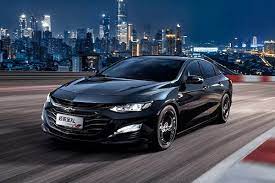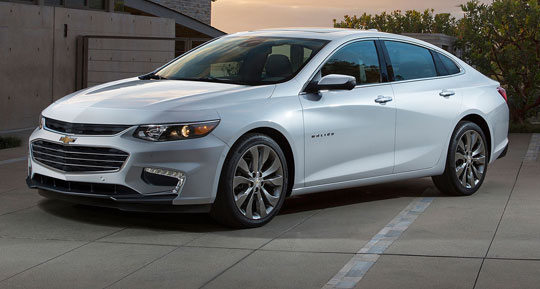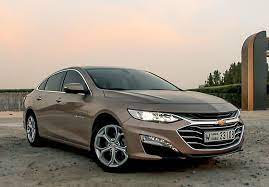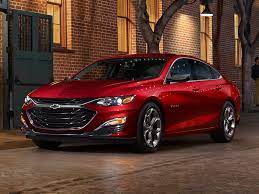The Chevrolet Malibu is a midsize sedan that has been a part of the American automaker’s lineup for many years. Its design and features have evolved over time, and it’s known for offering a comfortable ride, a spacious interior, and a range of technology options.
Here are some key aspects to consider when reviewing the Chevrolet Malibu:
Design and Comfort: The Malibu typically features a sleek and modern design. The interior is designed to provide comfort for both the driver and passengers. Depending on the trim level, you may find quality materials and various comfort features, such as power-adjustable seats and dual-zone climate control.
Performance: The Malibu usually offers a range of engine options, including fuel-efficient four-cylinder engines and more powerful options. The driving experience is generally smooth, and the car handles well, making it suitable for daily commuting and longer journeys.
Technology: Chevrolet tends to include a variety of technology features in the Malibu. This can include an infotainment system with a touchscreen display, smartphone integration (such as Apple CarPlay and Android Auto), Bluetooth connectivity, and available advanced safety features like lane departure warning and automatic emergency braking.
Safety: Safety features are an important consideration for many car buyers. The Malibu typically comes equipped with a range of safety features, and higher trim levels may offer additional advanced safety options.
Fuel Efficiency: Midsize sedans like the Malibu often prioritize fuel efficiency. Depending on the engine choice, the Malibu can offer competitive fuel economy, making it an economical choice for daily driving

Chevrolet Malibu car history:
The Chevrolet Malibu has a long history that spans several decades. Here is an overview of key points in the history of the Chevrolet Malibu:
First Generation (1964-1967): The Chevrolet Malibu was originally introduced in 1964 as a trim level for the Chevrolet Chevelle. It quickly gained popularity and became a separate model in 1978. The first generation was known for its midsize design and various body styles, including a sedan, coupe, convertible, and station wagon.
Second Generation (1968-1972): The second generation of the Malibu saw changes in its styling, with a more squared-off and formal appearance. It continued to offer various body styles, and during this era, Chevrolet introduced the SS (Super Sport) package for performance enthusiasts.
Third Generation (1973-1977): The third generation of the Malibu was characterized by its larger size and a focus on comfort. This generation included coupe, sedan, and station wagon models. Due to the oil crisis in the 1970s, there was a shift towards smaller, more fuel-efficient cars.
Fourth Generation (1978-1983): The Malibu became a standalone model in 1978, marking the beginning of the fourth generation. This generation featured a downsized design to meet the changing market demands for more fuel-efficient vehicles.
Fifth Generation (1997-2003): After a hiatus in production, the Malibu returned in 1997 as a midsize sedan. This generation marked a departure from the previous body-on-frame design to a more modern unibody construction. The Malibu received positive reviews for its updated styling and improved features.
Sixth Generation (2004-2007): The sixth generation of the Malibu brought a more contemporary design and increased emphasis on safety features. It aimed to compete more effectively with other midsize sedans in the market.
Seventh Generation (2008-2012): The seventh generation saw a complete redesign, featuring a more stylish exterior and a higher-quality interior. This generation included hybrid models as Chevrolet began to introduce more fuel-efficient options.
Eighth Generation (2013-2015): The eighth generation continued the trend of modern design and improved technology. The Malibu received updates to its styling, features, and available engines.
Ninth Generation (2016-2020): The ninth generation brought significant changes, including a lighter platform and a more aerodynamic design. It also featured advanced safety features and technology options, making it more competitive in the midsize sedan segment.

Chevrolet Malibu technical specifications:
Engine Options:
- The Chevrolet Malibu often offers a range of engine choices, including four-cylinder and six-cylinder options.
- Engine displacement, power output, and fuel efficiency can vary depending on the specific engine model.
Transmission:
- The Malibu typically comes with an automatic transmission, though the specific type (e.g., six-speed, eight-speed) may vary.
Performance:
- Acceleration times, top speed, and overall driving performance can vary based on the selected engine and trim level.
Fuel Efficiency:
- Midsize sedans are generally designed with fuel efficiency in mind. Look for specifications such as miles per gallon (MPG) for city and highway driving.
Chassis and Suspension:
- Information about the type of suspension system employed (e.g., independent suspension), which can affect ride comfort and handling.
Technology and Connectivity:
- Infotainment system details, including touchscreen size, smartphone integration (e.g., Apple CarPlay, Android Auto), and available navigation features.
- Safety and driver assistance features, such as lane departure warning, automatic emergency braking, and adaptive cruise control.
Safety Features:
- Information about standard and available safety features, including airbags, stability control, and advanced driver assistance systems.

Chevrolet Malibu in other countries:
Here are some general points about the Chevrolet Malibu in different countries:
North America: The Chevrolet Malibu has been a staple in the North American market, particularly in the United States and Canada. It is a popular choice among consumers looking for a midsize sedan.
China: General Motors has a significant presence in the Chinese automotive market, and the Malibu has been available there as well. In China, the Malibu is often positioned as a premium sedan.
South Korea: General Motors has a presence in South Korea, and the Malibu has been sold there, often as a Chevrolet model. It competes in the midsize sedan segment.
Middle East: The Chevrolet Malibu has been available in various Middle Eastern countries, offering consumers a midsize sedan option with features suitable for the local market.
Europe: While the Chevrolet brand phased out from mainstream sales in Europe around 2015, the Malibu was sold there for a limited time. Chevrolet’s focus in Europe has shifted more toward other vehicle types.
Australia: The Chevrolet Malibu was sold in Australia for a period. However, the Chevrolet brand withdrew from the Australian market in 2020, and General Motors shifted its focus to other brands, such as Holden.

Advantages and disadvantages of Chevrolet Malibu:
Keep in mind that specific details may vary by model year and trim level, so it’s essential to check the most recent information for the specific version you are interested in.
Here are some general pros and cons:
Advantages:
- Comfortable Ride: The Malibu is often praised for offering a comfortable and smooth ride, making it suitable for daily commuting and longer journeys.
- Spacious Interior: The midsize sedan typically provides a roomy interior with ample space for passengers in both the front and rear seats.
- Modern Design: The Malibu has undergone design updates over the years, featuring a more modern and stylish exterior.
- Technology Features: Depending on the trim level, the Malibu tends to offer a range of technology features, including an infotainment system, touchscreen display, and connectivity options such as Apple CarPlay and Android Auto.
- Fuel Efficiency: Many Malibu models are designed with fuel efficiency in mind, making them competitive in terms of miles per gallon.
- Safety Features: The Malibu often comes equipped with a variety of safety features, including airbags, stability control, and available advanced driver assistance systems.
Disadvantages:
- Limited Performance Options: While the Malibu provides a comfortable ride, it may not be the top choice for those seeking high-performance options compared to some sportier competitors.
- Trunk Space: Some users have noted that the trunk space in the Malibu may be smaller than that of some competitors, limiting cargo capacity.
- Interior Quality: While improvements have been made over the years, some critics have mentioned that certain interior materials may not be as high-quality as those in some competing models.
- Visibility: Like many modern sedans, the Malibu’s design might result in some visibility challenges, particularly in the rear, due to styling choices such as a sloping roofline.
- Resale Value: Historically, midsize sedans, including the Malibu, might experience faster depreciation compared to some other vehicle types, impacting resale value.
- Market Trends: The automotive market has seen a shift toward SUVs and crossovers, impacting the popularity of traditional sedans like the Malibu.

Conclusion:
The Chevrolet Malibu, a midsize sedan with a legacy spanning several decades, offers a blend of comfort, style, and practicality. Over its various generations, the Malibu has evolved to meet changing market demands, incorporating modern design elements, advanced technology features, and a focus on fuel efficiency.
One of the notable strengths of the Malibu lies in its comfortable ride and spacious interior, providing a welcoming environment for both drivers and passengers. The inclusion of technology features, such as touchscreen infotainment systems and connectivity options, caters to the expectations of today’s tech-savvy consumers.
However, the Malibu faces challenges common to the midsize sedan segment, including the trend toward SUVs and crossovers, impacting the popularity of traditional sedans. Some users have pointed out specific considerations such as trunk space, interior materials, and visibility as areas where the Malibu may have room for improvement.
Ultimately, the suitability of the Chevrolet Malibu depends on individual preferences and needs. For those seeking a reliable and comfortable sedan for daily commuting and family use, the Malibu has historically been a reasonable choice. As with any vehicle, it’s crucial to consider the specific model year, trim level, and personal priorities to ensure the chosen Malibu aligns with the desired features and performance characteristics. Prospective buyers are encouraged to explore the latest reviews, conduct test drives, and consult with Chevrolet dealerships for the most up-to-date information on this enduring midsize sedan.
For more information, visit the official Chevrolet Malibu website
Read this article: chevrolet camaro review

Leave a Reply